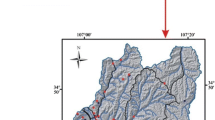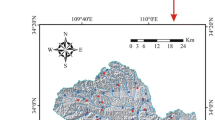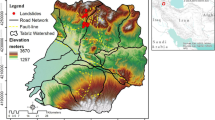Abstract
The main objective of this study is to investigate the potential application of GIS-based Support Vector Machines (SVM) with four kernel functions, i.e., radial basis function (RBF), polynomial (PL), sigmoid (SIG), and linear (LN) for landslide susceptibility mapping at Luxi city in Jiangxi province, China. At the first stage of the study, a landslide inventory map with 282 landslide locations was identified using aerial photographs, satellite images, and field surveys. Of this, 70 % of the landslides (196 landslide locations) are used as a training dataset and the rest (86 landslide locations) were used as the validation dataset. Then, 15 landslide conditioning factors were prepared, i.e., altitude, aspect, slope, stream power index (SPI), topographic wetness index (TWI), sediment transport index (STI), plan curvature, profile curvature, distance from river, distance from road, distance from fault, lithology, land use, NDVI, and rainfall. Using these conditioning factors, landslide susceptibility indexes were calculated using SVM with the four kernel functions. Subsequently, the results were exported and plotted in ArcGIS and four landslide susceptibility maps were produced. The four susceptibility maps were validated and compared using the landslide locations and the success rate and prediction rate methods. The validation results showed that success rates for the four SVM models are 82.0 % (RBF), 83.0 % (PL), 45.0 % (SIG), and 70.0 % (LN). The prediction rates for the four SVM models are 81.0 % (RBF), 71.0 % (PL), 40.0 % (SIG), and LN 63.0 % (SIG). The result shows that the RBF-SVM model has the highest overall performance. The produced susceptibility maps may be useful for general land-use planning in landslides.







Similar content being viewed by others
References
Abe S (2010) Support vector machines for pattern classification. Springer, London. doi:10.1007/978-1-84996-098-4
Akgun A, Turk N (2011) Mapping erosion susceptibility by a multivariate statistical method: a case study from the AyvalIk region, NW Turkey. Comput Geosci 37:1515–1524. doi:10.1016/j.cageo.2010.09.006
Ali S, Smith KA (2003) Automatic parameter selection for polynomial kernel. Proceedings of the 2003 IEEE international conference on information reuse and integration. doi:10.1109/iri.2003.1251420
Arıkan F, Ulusay R, Aydın N (2007) Characterization of weathered acidic volcanic rocks and a weathering classification based on a rating system. B Eng Geol Environ 66:415–430. doi:10.1007/s10064-007-0087-0
Bai S-B, Wang J, Lü G-N, Zhou P-G, Hou S-S, Xu S-N (2010) GIS-based logistic regression for landslide susceptibility mapping of the Zhongxian segment in the Three Gorges area, China. Geomorphology 115:23–31
Ballabio C, Sterlacchini S (2012) Support vector machines for landslide susceptibility mapping: the Staffora River Basin case study, Italy. Math Geosci 44:47–70. doi:10.1007/s11004-011-9379-9
Chang CC, Lin CJ (2011) A library for support vector machines. National Taiwan University, Taipei
Chapelle O, Vapnik V, Bousquet O, Mukherjee S (2002) Choosing multiple parameters for support vector machines. Mach Learn 46:131–159. doi:10.1023/a:1012450327387
Chen S, Luo Z, Pan X (2013) Natural disasters in China: 1900–2011. Nat Hazards 69:1597–1605. doi:10.1007/s11069-013-0765-0
Cherkassky V, Mulier F (2007) Learning from data: concepts, theory and methods. Wiley, New York
Choi J, Oh H-J, Lee H-J, Lee C, Lee S (2012) Combining landslide susceptibility maps obtained from frequency ratio, logistic regression, and artificial neural network models using ASTER images and GIS. Eng Geol 124:12–23
Chung CJF, Fabbri AG, Van westen CJ (1995) Multivariate regression analysis for landslide hazard zonation. In: Carrara A, Guzzetti F (eds) Geographical information systems in assessing natural hazards, vol 5. pp 107–133
Cruden DM, Varnes DJ (1996) Landslide types and processes. In: Turner AK, Schuster RL (eds) Landslides, investigation and mitigation. Transportation Research Board, Washington, pp 36–75 (Vol special report 247)
Dai FC, Lee CF, Li J, Xu JW (2001) Assesment of Landslide susceptibility on the natural terrain of Lantau Island, Hong Kong. Environl Geol 40:381–391
Devkota KC, Regmi AD, Pourghasemi HR, Yoshida K, Pradhan B, Ryu IC, Dhital MR, Althuwaynee O (2013) Landslide susceptibility mapping using certainty factor, index of entropy and logistic regression models in GIS and their comparison at Mugling-Narayanghat road section in Nepal Himalaya. Nat Hazards 65(1):135–165. doi:10.1007/s11069-012-0347-6
Gorsevski PV, Gessler PE, Foltz RB, Elliot WJ (2006) Spatial prediction of landslide hazard using logistic regression and ROC analysis. Trans GIS 10:395–415
Greco R, Sorriso-Valvo M (2013) Influence of management of variables, sampling zones and land units on LR analysis for landslide spatial prevision. Nat Hazards Earth Sys Sci 13:2209–2221
Guzzetti F, Reichenbach P, Cardinali M, Galli M, Ardizzone F (2005) Probabilistic landslide hazard assessment at the basin scale. Geomorphology 72:272–299. doi:10.1016/j.geomorph.2005.06.002
Guzzetti F, Reichenbach P, Ardizzone F, Cardinali M, Galli M (2006) Estimating the quality of landslide susceptibility models. Geomorphology 81:166–184
Hsu CW, Chang CC, Lin CJ (2003) A practical guide to support vector classification
Wang JA, Shi PJ, Yi XS, Jia HC, Zhu LY (2008) The regionalization of urban natural disasters in China. Nat Hazards 44:169–179. doi:10.1007/s11069-006-9102-1
Jebur MN, Pradhan B, Tehrany MS (2014) Optimization of landslide conditioning factors using very high-resolution airborne laser scanning (LiDAR) data at catchment scale. Remote Sens Environ 152:150–165. doi:10.1016/j.rse.2014.05.013
Li C, Tang H, Ge Y, Hu X, Wang L (2014) Application of back-propagation neural network on bank destruction forecasting for accumulative landslides in the three Gorges Reservoir Region, China. Stoch Env Res Risk Assess 28:1465–1477. doi:10.1007/s00477-014-0848-9
Manzo G, Tofani V, Segoni S, Battistini A, Catani F (2012) GIS techniques for regional-scale landslide susceptibility assessment: the Sicily (Italy) case study. Int J Geogr Inf Sci 27:1433–1452. doi:10.1080/13658816.2012.693614
Marjanovic M, Kovacevic M, Bajat B, Vozenílek V (2011) Landslide susceptibility assessment using SVM machine learning algorithm. Eng Geol 123:225–234. doi:10.1016/j.enggeo.2011.09.006
Mathew J, Jha VK, Rawat GS (2007) Application of binary logistic regression analysis and its validation for landslide susceptibility mapping in part of Garhwal Himalaya, India. Int J Remote Sens 28:2257–2275. doi:10.1080/01431160600928583
Micheletti N, Foresti L, Robert S, Leuenberger M, Pedrazzini A, Jaboyedoff M, Kanevski M (2014) Machine learning feature selection methods for landslide susceptibility mapping. Math Geosci 46:33–57. doi:10.1007/s11004-013-9511-0
Nefeslioglu HA, Sezer E, Gokceoglu C, Bozkir AS, Duman TY (2010) Assessment of landslide susceptibility by decision trees in the metropolitan area of Istanbul, Turkey. Math Probl Eng 2010:1–15. doi:10.1155/2010/901095
Pavel M, Nelson JD, Jonathan Fannin R (2011) An analysis of landslide susceptibility zonation using a subjective geomorphic mapping and existing landslides. Comp Geosci 37:554–566
Petley D (2012) Global patterns of loss of life from landslides. Geology 40(10):927–930. doi:10.1130/g33217.1
Petrucci O, Pasqua A (2009) A methodological approach to characterise landslide periods based on historical series of rainfall and landslide damage. Nat Hazards Earth Sys Sci 9:1655–1670
Platt J (2000) Probabilistic outputs for support vector machines and comparison to regularized likelihood methods. MIT Pres, Cambridge
Polykretis C, Ferentinou M, Chalkias C (2014) A comparative study of landslide susceptibility mapping using landslide susceptibility index and artificial neural networks in the Krios River and Krathis River catchments (northern Peloponnesus, Greece). B Eng Geol Environ 74:27–45. doi:10.1007/s10064-014-0607-7
Pourghasemi H, Pradhan B, Gokceoglu C (2012) Application of fuzzy logic and analytical hierarchy process (AHP) to landslide susceptibility mapping at Haraz watershed, Iran. Nat Hazards 63:965–996. doi:10.1007/s11069-012-0217-2
Pradhan B (2010) Remote sensing and GIS-based landslide hazard analysis and cross-validation using multivariate logistic regression model on three test areas in Malaysia. Adv Space Res 45:1244–1256. doi:10.1016/j.asr.2010.01.006
Pradhan B (2013) A comparative study on the predictive ability of the decision tree, support vector machine and neuro-fuzzy models in landslide susceptibility mapping using GIS. Comput Geosci 51:350–365. doi:10.1016/j.cageo.2012.08.023
Pradhan B, Lee S (2010) Landslide susceptibility assessment and factor effect analysis: backpropagation artificial neural networks and their comparison with frequency ratio and bivariate logistic regression modelling. Environ Modell Softw 25:747–759. doi:10.1016/j.envsoft.2009.10.016
Pradhan B, Sezer EA, Gokceoglu C, Buchroithner MF (2010) Landslide susceptibility mapping by neuro-fuzzy approach in a landslide-prone area (Cameron Highlands, Malaysia). IEEE Trans Geosci Remote 48:4164–4177
Sezer EA, Pradhan B, Gokceoglu C (2011) Manifestation of an adaptive neuro-fuzzy model on landslide susceptibility mapping: Klang valley, Malaysia. Expert Syst Appl 38:8208–8219. doi:10.1016/j.eswa.2010.12.167
Song ST, Zhan ZC, Long ZY, Zhang JC, Yao L (2011) Comparative study of SVM methods Combined with voxel selection for object category classification on fMRI data. Plos One 6(2):e17191. doi:10.1371/journal.pone.0017191
Suzen ML, Doyuran V (2004) A comparison of the GIS based landslide susceptibility assessment methods: multivariate versus bivariate. Environ Geol 45:665–679. doi:10.1007/s00254-003-0917-8
Suzen ML, Kaya BS (2012) Evaluation of environmental parameters in logistic regression models for landslide susceptibility mapping. Int J Digit Earth 5:338–355. doi:10.1080/17538947.2011.586443
Tehrany MS, Pradhan B, Jebur MN (2014) Flood susceptibility mapping using a novel ensemble weights-of-evidence and support vector machine models in GIS. J Hydrol 512:332–343. doi:10.1016/j.jhydrol.2014.03.008
Tein Bui D, Pradhan B, Revhaug I, Tran CT (2014) A Comparative assessment between the application of fuzzy unordered rules induction algorithm and j48 decision tree models in spatial prediction of shallow landslides at Lang Son City, Vietnam. In: Srivastava PK, Mukherjee S, Gupta M, Islam T (eds) Remote sensing applications in environmental research. society of earth scientists series. Springer International Publishing, New York, pp 87–111. doi:10.1007/978-3-319-05906-8_6
Tien Bui D (2012) Modeling of rainfall-induced landslide hazard for the Hoa Binh province of Vietnam. Norwegian University of Life Sciences. Ph.D thesis. doi: 10.13140/2.1.2038.0969
Tien Bui D, Lofman O, Revhaug I, Dick O (2011) Landslide susceptibility analysis in the Hoa Binh province of Vietnam using statistical index and logistic regression. Nat Hazards 59:1413–1444. doi:10.1007/s11069-011-9844-2
Tien Bui D, Pradhan B, Lofman O, Revhaug I (2012a) Landslide susceptibility assessment in Vietnam using support vector machines, decision tree and Naïve Bayes models. Math Probl Eng 2012:1–26
Tien Bui D, Pradhan B, Lofman O, Revhaug I, Dick OB (2012) Application of support vector machines in landslide susceptibility assessment for the Hoa Binh province (Vietnam) with kernel functions analysis. In: Seppelt R, Voinov AA, Lange S, Bankamp D (eds) Proceedings of the iEMSs sixth biennial meeting,: international congress on environmental modelling and software (iEMSs 2012). International environmental modelling and software society, Leipzig, Germany, July 2012
Tien Bui D, Pradhan B, Lofman O, Revhaug I, Dick OB (2012c) Landslide susceptibility assessment in the Hoa Binh province of Vietnam: a comparison of the Levenberg-Marquardt and Bayesian regularized neural networks. Geomorphology 171–172:12–29
Tien Bui D, Pradhan B, Lofman O, Revhaug I, Dick OB (2012d) Landslide susceptibility mapping at Hoa Binh province (Vietnam) using an adaptive neuro-fuzzy inference system and GIS. Comp Geosci 45:199–211. doi:10.1016/j.cageo.2011.10.031
Tien Bui D, Pradhan B, Lofman O, Revhaug I, Dick OB (2012e) Spatial prediction of landslide hazards in Hoa Binh province (Vietnam): a comparative assessment of the efficacy of evidential belief functions and fuzzy logic models. CATENA 96:28–40. doi:10.1016/j.catena.2012.04.001
Tien Bui D, Ho TC, Revhaug I, Pradhan B, Nguyen D (2013a) Landslide susceptibility mapping along the national road 32 of Vietnam using GIS-based J48 decision tree classifier and its ensembles. In: Buchroithner M, Burghardt D (eds) Cartography from pole to pole. Lecture notes in geoinformation and cartography. Springer, Berlin, pp 303–317. doi:10.1007/978-3-642-32618-9_22
Tien Bui D, Pradhan B, Lofman O, Revhaug I, Dick O (2013b) Regional prediction of landslide hazard using probability analysis of intense rainfall in the Hoa Binh province, Vietnam. Nat Hazards 66:707–730
Tien Bui D, Tin DQ, Ha VP, Revhaug I, Lien VN, Ha TT, Hoa LB (2013) Spatial prediction of landslide hazard along the national road 32 of Vietnam: A comparison between support vector machines, radial basis function neural networks, and their ensembles. In: Geohazards: impacts and challenges for society development in Asian countries, 49th CCOP Annual Session, Sendai, Japan. Geological Survey of Japan, pp 161–171
Tien Bui D, Tuan TA, Klempe H, Pradhan B, Revhaug I (2015) Spatial prediction models for shallow landslide hazards: a comparative assessment of the efficacy of support vector machines, artificial neural networks, kernel logistic regression, and logistic model tree. Landslides. doi:10.1007/s10346-015-0557-6
Van Den Eeckhaut M, Vanwalleghem T, Poesen J, Govers G, Verstraeten G, Vandekerckhove L (2006) Prediction of landslide susceptibility using rare events logistic regression: a case-study in the Flemish Ardennes (Belgium). Geomorphology 76:392–410. doi:10.1016/j.geomorph.2005.12.003
Vapnik VN (1998) Statistical learning theory. Wiley-Interscience, New York
Varnes DJ (1984) Landslide hazard zonation: a review of principles and practice. UNESCO, Paris
Were K, Tien Bui D, Dick ØB, Singh BR (2015) A comparative assessment of support vector regression, artificial neural networks, and random forests for predicting and mapping soil organic carbon stocks across an Afromontane landscape. Ecol Indic 52:394–403
Wu K-P, Wang S-D (2009) Choosing the kernel parameters for support vector machines by the inter-cluster distance in the feature space. Pattern Recogn 42:710–717. doi:10.1016/j.patcog.2008.08.030
Yang XJ, Lin A, Li X-L, Wu Y, Zhou W, Chen Z (2013) China’s ion-adsorption rare earth resources, mining consequences and preservation. Environ Dev 8:131–136. doi:10.1016/j.envdev.2013.03.006
Yao X, Tham LG, Dai FC (2008) Landslide susceptibility mapping based on support vector machine: a case study on natural slopes of Hong Kong, China. Geomorphology 101:572–582. doi:10.1016/j.geomorph.2008.02.011
Yeon Y-K, Han J-G, Ryu KH (2010) Landslide susceptibility mapping in Injae, Korea, using a decision tree. Eng Geol 116:274–283. doi:10.1016/j.enggeo.2010.09.009
Zare M, Pourghasemi H, Vafakhah M, Pradhan B (2013) Landslide susceptibility mapping at Vaz Watershed (Iran) using an artificial neural network model: a comparison between multilayer perceptron (MLP) and radial basic function (RBF) algorithms. Arab J Geosci 6:2873–2888. doi:10.1007/s12517-012-0610-x
Zhuang L, Dai HH (2006) Parameter optimization of kernel-based one-class classifier on imbalance text learning. Pricai 2006 Trends Artifi Intell 4099:434–443
Acknowledgments
This research was supported by the National Natural Science Foundation of China (41472202, 41202235). Thanks to anonymous reviewer and Editorial comment by Professor James W. LaMoreaux which helped us to improve the quality of the manuscript.
Author information
Authors and Affiliations
Corresponding author
Rights and permissions
About this article
Cite this article
Hong, H., Pradhan, B., Jebur, M.N. et al. Spatial prediction of landslide hazard at the Luxi area (China) using support vector machines. Environ Earth Sci 75, 40 (2016). https://doi.org/10.1007/s12665-015-4866-9
Received:
Accepted:
Published:
DOI: https://doi.org/10.1007/s12665-015-4866-9




